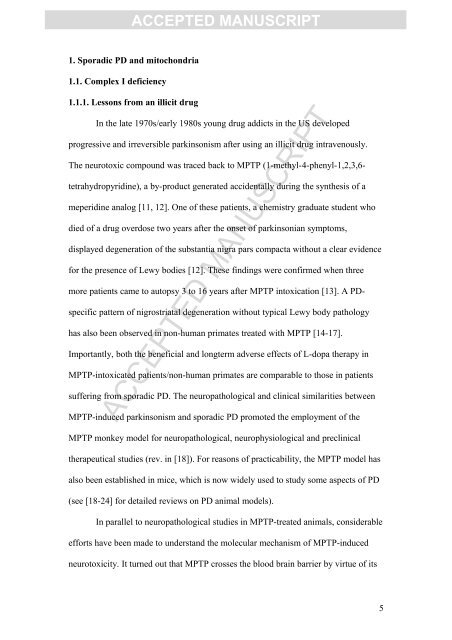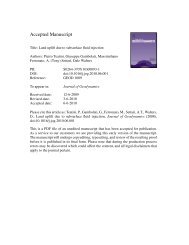accepted manuscript
accepted manuscript
accepted manuscript
Create successful ePaper yourself
Turn your PDF publications into a flip-book with our unique Google optimized e-Paper software.
ACCEPTED MANUSCRIPT<br />
1. Sporadic PD and mitochondria<br />
1.1. Complex I deficiency<br />
1.1.1. Lessons from an illicit drug<br />
In the late 1970s/early 1980s young drug addicts in the US developed<br />
progressive and irreversible parkinsonism after using an illicit drug intravenously.<br />
The neurotoxic compound was traced back to MPTP (1-methyl-4-phenyl-1,2,3,6-<br />
tetrahydropyridine), a by-product generated accidentally during the synthesis of a<br />
meperidine analog [11, 12]. One of these patients, a chemistry graduate student who<br />
died of a drug overdose two years after the onset of parkinsonian symptoms,<br />
displayed degeneration of the substantia nigra pars compacta without a clear evidence<br />
for the presence of Lewy bodies [12]. These findings were confirmed when three<br />
more patients came to autopsy 3 to 16 years after MPTP intoxication [13]. A PD-<br />
specific pattern of nigrostriatal degeneration without typical Lewy body pathology<br />
has also been observed in non-human primates treated with MPTP [14-17].<br />
Importantly, both the beneficial and longterm adverse effects of L-dopa therapy in<br />
MPTP-intoxicated patients/non-human primates are comparable to those in patients<br />
suffering from sporadic PD. The neuropathological and clinical similarities between<br />
ACCEPTED MANUSCRIPT<br />
MPTP-induced parkinsonism and sporadic PD promoted the employment of the<br />
MPTP monkey model for neuropathological, neurophysiological and preclinical<br />
therapeutical studies (rev. in [18]). For reasons of practicability, the MPTP model has<br />
also been established in mice, which is now widely used to study some aspects of PD<br />
(see [18-24] for detailed reviews on PD animal models).<br />
In parallel to neuropathological studies in MPTP-treated animals, considerable<br />
efforts have been made to understand the molecular mechanism of MPTP-induced<br />
neurotoxicity. It turned out that MPTP crosses the blood brain barrier by virtue of its<br />
5
















